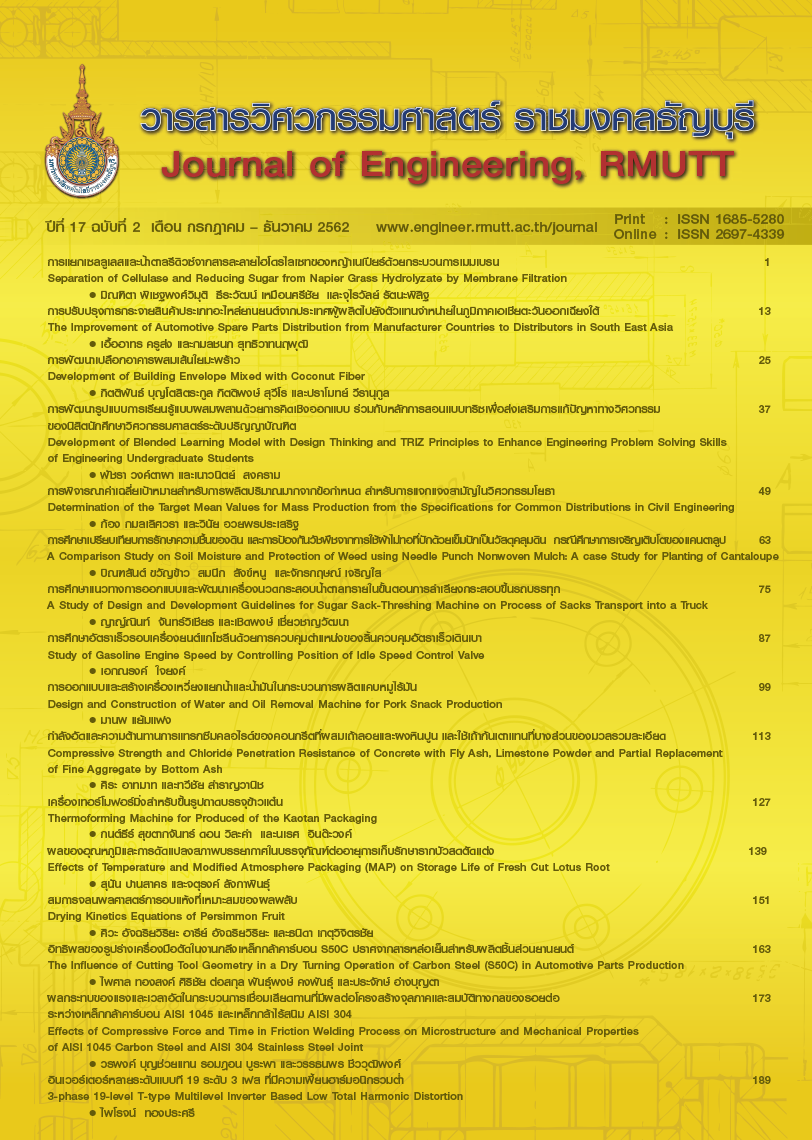Study of Gasoline Engine Speed by Controlling Position of Idle Speed Control Valve
Main Article Content
Abstract
The objective of this research was to design a gasoline engine speed control system by using Idle Speed Control Valve (ISCV). The engine of interest was a 115 cc. single-cylinder YAMAHA engine with a carburetor. It was modeled as a first-order linear system for simplicity, and was verified by using MATLAB R2011a. Using the C programming language, a dsPIC30F4011 microcontroller was programmed as the controller. The Chien-Hrones-Reswick (CHR) graphical techniques were used to obtain the PID controller gains when unit step reference inputs were applied to the control system. For this, two possibilities associated with the CHR technique were examined, namely PID 20% overshoot and PID least overshoot. It was found that the PID least overshoot method yielded satisfactory overshoot and performance. Performance of the control system was examined in three experiments. These included constant engine speed control, increasing speed control, and breaking disturbance rejection. It appeared from these experiments that, the output of the system could reach a constant speed reference input within 1.9 seconds, with no overshoot. The breaking disturbance was rejected within 6 seconds.
Article Details
The manuscript, information, content, picture and so forth which were published on Frontiers in engineering innovation research has been a copyright of this journal only. There is not allow anyone or any organize to duplicate all content or some document for unethical publication.
References
Spear B. James Watt: the steam engine and the commer-cialization of patents. World Patent Information. 2008 Mar; 30(1):53-8.
Ogata KS. Modern control engineering. 4th ed. New Jersey: Aeeizh; 2002.
DENSO. Engine management systems catalogue 2014/2015; 2014.
Hu L, Wang Y. Design and simulate the idle speed control system based on fuzzy adaptive. IEEE Advanced Information Tech-nology Electronic and Automation Control Conference [Internet]. 2016 [cited 2019 Feb 6]:714–7. Available from: http://ieeexplore.ieee.org/document/7428648/
Mu H, Li X, Tang J. Study with fuzzy self-turning PID controller on idle speed controlling of automobile. Chinese Automa-tion Congress Conference [Internet]. 2017 [cited 2019 Feb 25]:5755–9. Available from: http://ieeexplore.ieee.org/document/8243811/
Rout MK, Sain D, Swain SK, Mishra SK. PID controller design for cruise control system using genetic algorithm. IEEE International Electrical Elec-tronics and Optimization Techniques Conference [Internet]. 2016 [cited 2019 Feb 25]:4170–4. Available from: http://ieeexplore.ieee.org/document/7755502/
Shima T, inventor; Nissan Motor Co Ltd., assignee. Vehicle cruise control system. United States patent US7440835B2. 2008 Oct 21.
Sekine H, Sugimoto Y, inventor; Honda Motor Co Ltd., assignee. Adaptive cruise control appa-ratus. United States patent US9162677B2. 2015 Oct 20.
Honda Motor. 1991 CIVICS 3/4 DR servic manual. Printed in USA.; 1991.
Toyota Motor Sales. Engine controls part3 idle speed control [internet]. 2018 [cited 2018 Dec 10]:1-14. Available from: https://www. lovehorsepower.com/ToyotaPDFs/26.PDF.
Arisariyawong S. How to adjust the gain of the PID controller In case of not knowing mathe-matical model (chapter 1). Industrial Technology Review Magazine. 2005 Sep;11:142-6. (in thai)
Janjornmanit S. Linear systems control. RMUTL: The Book centre of Electrical Engineering RMUTL; 2012. (in Thai)
Xue D, Chen Y, Atherton DP. Linear feedback control analysis and design with MATLAB. Philadelphia USA.: The Society for Industrial and Applied Mathematics; 2007.
Sinha RK, Bhakta S, Pal P. Design of a PID controller for unstable system: a pole-placement based firefly approach. IEEE International Computation of Power Energy Information and Communication Conference [Internet]. 2018 [cited 2019 Feb 25]:356–62. Available from: https://ieeexplore.ieee.org/document/8525203/


